The History of Dunhill's Shell
The documented history of Dunhill's inception of the Shell is largely limited to patent applications — there are no catalogue pages or advertisements promoting blasted pipes at the time. The preliminary work on the English patent (No. 1484/17) was submitted on October 13, 1917. The patent submission was completed half a year later, on April 12, 1918, followed by the granting of the English patent on October 14, 1918. This was less than a month before the end of The Great War on November 11th.
The American patent application (No. 1,341,418) was prepared and filed before the English patent was granted, between September 19 and October 14, 1918. The American patent was granted more than a year later, on May 25, 1920. Canadian documents were behind the U.S. a year, with application in 1919 and granted in 1921.
The numerical code system for indicating date of manufacture started in 1922, but occasionally we find pipes that can be dated before 1922, specifically, those that were Stamped: "DUNHILL'S SHELL" - "MADE IN ENGLAND", followed by "PAT. MAR. 9.15" with "PAT. APP FOR" and "AT. 1914" with "PAT. APP FOR". These patent references are for the U.S. and Canada respectively. These impressions possibly date from the patent application, not the granting. It is hard to say with certainty, but it is speculated that the Shell was first marketed in mid-1917 while the patent process was underway. The blasting tests were run and improved starting in 1914 with support of the London Sandblasting Company, which specialized in glass blasting.
Jonathan Guss and Jesse Silver, important members of our community, point out inconsistencies in the main story that is widespread, which states that the blasting of pipes was invented by Dunhill. The blasting technique was invented in 1870, and patented by Benjamin Chew Tilghman, 47 years before Dunhill used it in his pipes. There is no way to say for sure who was the first to apply the concept in pipes. There are clues and theories that point to sandblasting of pipes before Dunhill, by Barling, for example, in a model called "Niblick" in mid-1917. Guss points out that the patent is more related to the process Dunhill used than the blasting itself. Alfred Dunhill explained the process of oil curing and sandblasting in his patent application as follows:
"This invention refers to the treatment of the surface of the pipe, for decorative purposes. This is the process by which the grain is accentuated in relief, thus giving the wood a very elegant appearance, without interfering in the durability and quality of the pipe. Although sand blasting has been used previously for the treatment of wood surface and grain accentuation, I have found in practice that this treatment alone did not give satisfactory results, as there is a tendency for wood to fissure, Result that does not occur with my auxiliary process of treatment by maceration in oil and heat.
The briar is soaked in mineral or vegetable oil. For example, in the case of the Algerian briar (a wood very suitable for the production of these new pipes). The piece can be soaked for a long period, say, for several weeks. After it has been removed from the oil, subject to heat action. This process takes many days. The exudate oil rests on the surface and is being removed periodically. The result of the treatment is that the grain of the wood is hardened and stands out in a certain degree, while the oil forms a waterproof coating.
After that, the wood is subjected to the action of the sandblasting, which removes the hardened oil coating and also infers the cutting effect. If the result is not satisfactory, it will be soaked again in oil, treated with heat and sandblasting; And so on, as many times as necessary, according to the extent to which you want to accentuate the grain or highlight it in relief. The resulting piece is extremely beautiful and constitutes an admirable smoking tobacco pipe."
Alfred's invention therefore concerns treatment and curing of the Briar in oils, strengthening it as it removes impurities:
The conception of sandblasting is reported in the book "About Smoke", released in mid-1920. Algeria had become an important source of briar, and Alfred Dunhill bought his first shipment in early 1914. Impressed with the beauty and richness of the grain of his new briar stock, he tried to put it into production, but soon found that the results were not satisfactory on account of the softness of the material. Unused briar blocks were subsequently put aside and forgotten for months near the furnace. At random, sometime the next summer, he decided to re-examine these blocks and realized that some of the grains had shrunk, highlighting the grain and leaving a pattern of relief similar to that of a seashell--clearly the result of its prolonged exposure to Heat. The once voluminous wood was reduced to a mere shell of its former self, assuming a new and fascinating appearance while also becoming much lighter. These two factors combined created the perfect quality for both beautiful unique pieces and excellent smoking properties. The classic and iconic "Dunhill Shell Briar" is born!
In addition to the registered patents, we have the mark between parentheses below the "Briar"-(REGD). There were two records, one for "The Briar Shell ", requested at the English Intellectual Property Office (IPO) on February 19, 1921, published on March 30 of the same year, and expired on February 20, 2015, without renewal. The other record went to "Dunhill's Shell Briar", requested on May 19, 1921, published on June 29 of the same year and renewed on February 04, 2015.
Dunhill did not fully develop the sandblasting techniques until the mid-1920's. The first specimens were deeply marked, drastically altering the shape of the pipe by double blasting. By the end of the 1920's the technique was perfected, the results were blasts with more personality and beauty, while also retaining the shape of the pipe. The pieces of this era are the highest regarded by collectors. This blasting style was practiced until the early 1960's.
In the 1960's, the Italian government restricted the use of the Briar to Italian manufacturers and the Algerian briar became scarce (consequence of the Algerian War of Independence. 1954-1962), which forced Dunhill to use the somewhat harder Greek briar. This compromised the sandblasted finish and explains why the blast is superficial in the models from this time period. Between the end of the 1960's and the beginning of the 1970's, it was possible to perform a deeper blast on this briar, but the market did not embrace it. Dunhill responded by preserving the smoother blasting. It is said that Richard Dunhill took one of the Shells that were rejected and asked:
— Why is this in the rejection bin?
— Because the sandblasting is very deep and irregular.
— That pipe has a personality. Send it to America. The Americans know good pipes! "
See The Art of Sandblasting, and by R.D. Field, for an in depth look at Dunhill's revolutionary new finish. Concluding, the deepest and craggiest finishes were from Algerian briar, which is softer and yields more to the blasting. These are found in circa 1920's, 1940's, and 1960's Shells. The pipes were double blasted until the 1960's, and then the double blast technique resumed in the 1980's calling it the "Deep Shell" finish. During the 1960’s and 70’s Dunhill could not acquire the Algerian briar. Consequently, the company’s sandblast pipes were much shallower and less distinct. Once again Dunhill showed itself to be innovative, inventing the “double blast” technique to bring about a deeper blast even with harder briar. The black shell sandblast finish uses a stain the was developed for the color, not the taste. Some enthusiasts experience them having a more bitter taste, even when judiciously smoked.
In the 1990's there was a return to the first blasting techniques. These blasts had more personality, but nothing compared to the pipes of the past. The dyeing of this line was a dark wine color, which exposed to light presented a reddish tone to this series. At some point in the 1960's, the color was altered to black, but this too was rejected, and the original coloration was restored. Here we have some examples of the variations the process has undergone through the years:
Two very early examples. The top piece is from 1918, and carries the #24 stamp (the size of the “Inner Tube,” not the shape). This pipe would later be referred to as the “O” in the catalogue. The bottom pipe is a 1925 PO shape in exquisite condition. From the G.L. Pease Collection [1]
A 1927 Dunhill Shell Patent Pipe 120 Shape Bottom: A 1965 Dunhill Shell 120 Shape - Note how the size, depth of sandblast, and overall design changed over time. It should be noted that the 1927 model has a replacement mouthpiece, and has had a shank repair. Early 120 shape pipes are notorious for having thin and elegant shanks that are prone to breakage - Courtesy of Mike Ahmadi
A 1937 Shell LB, G.L. Pease collection [2]

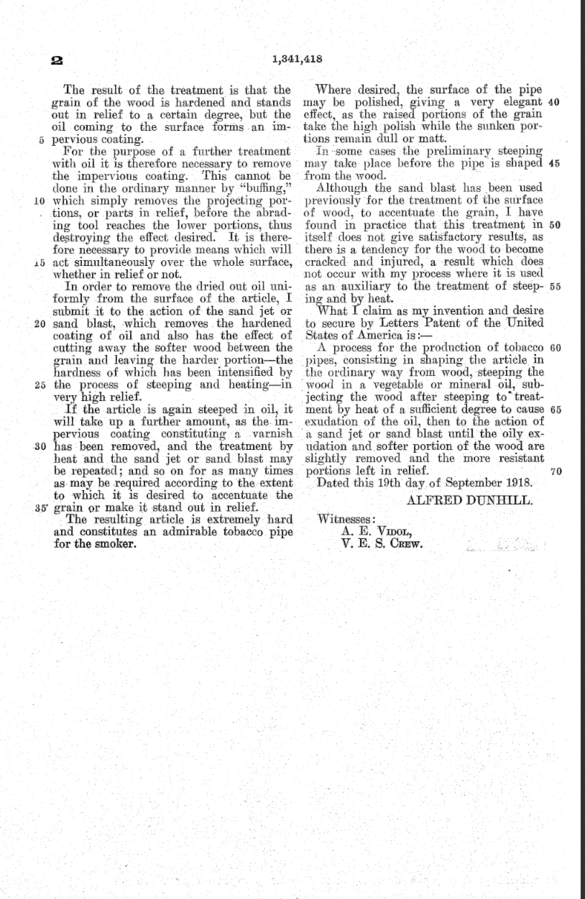
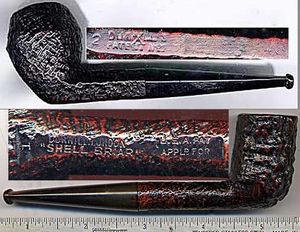
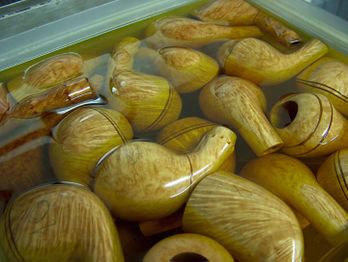
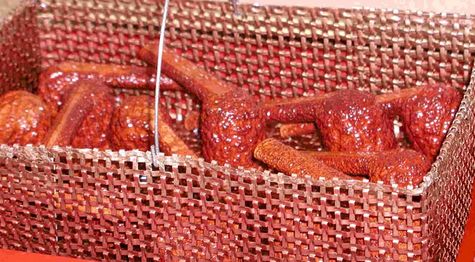
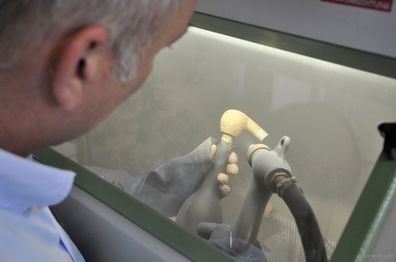
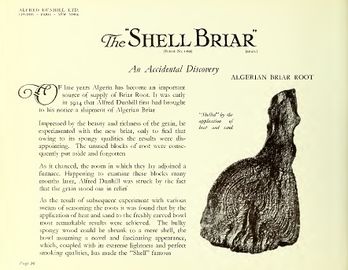
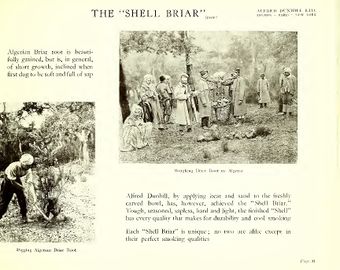
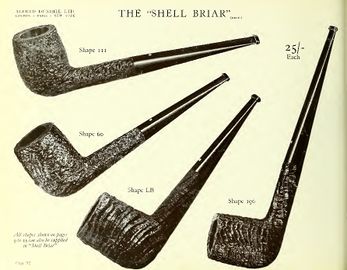
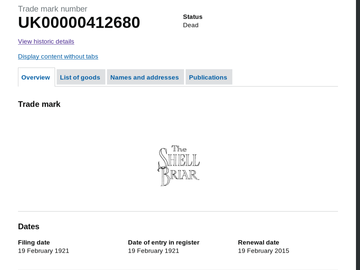
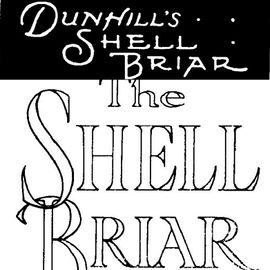
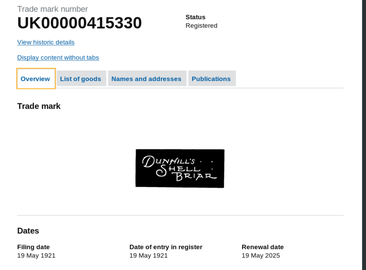
![Two very early examples. The top piece is from 1918, and carries the #24 stamp (the size of the “Inner Tube,” not the shape). This pipe would later be referred to as the “O” in the catalogue. The bottom pipe is a 1925 PO shape in exquisite condition. From the G.L. Pease Collection [1]](/images/thumb/4/4b/DunhillD.jpg/256px-DunhillD.jpg)
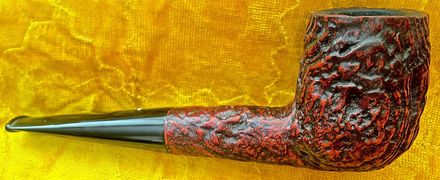
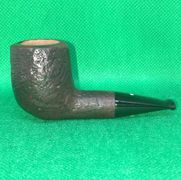
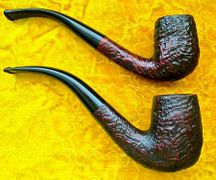
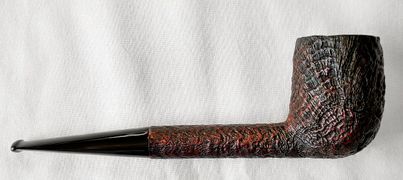
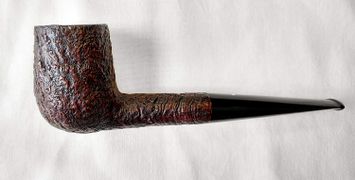
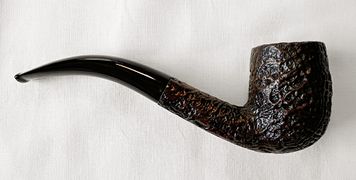
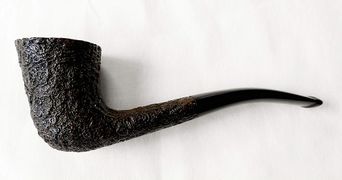
![A 1937 Shell LB, G.L. Pease collection [2]](/images/thumb/f/f2/DunhillI.jpg/232px-DunhillI.jpg)